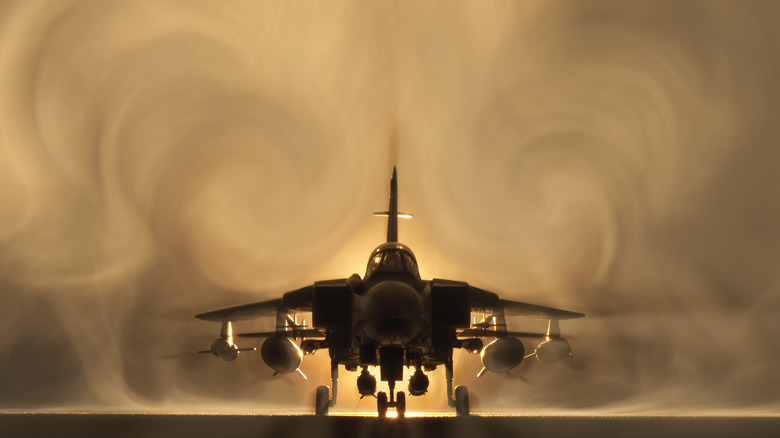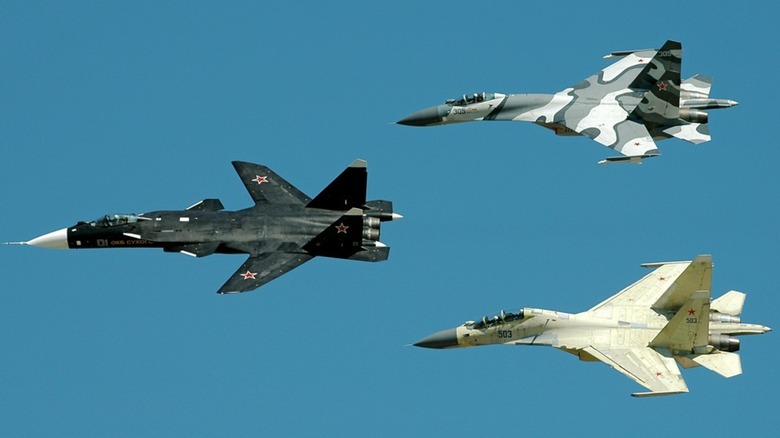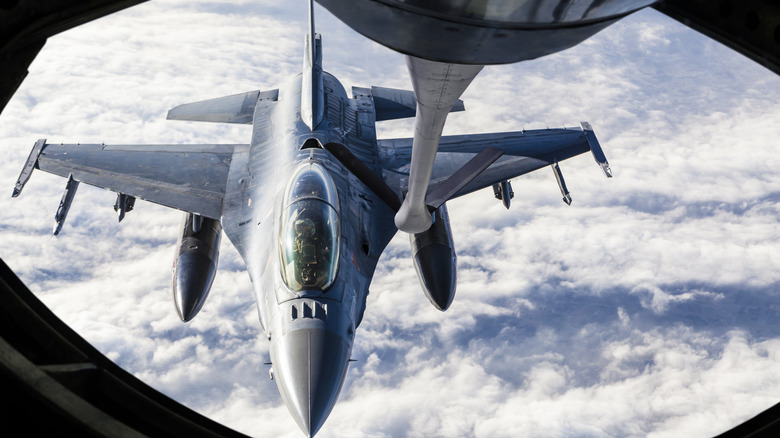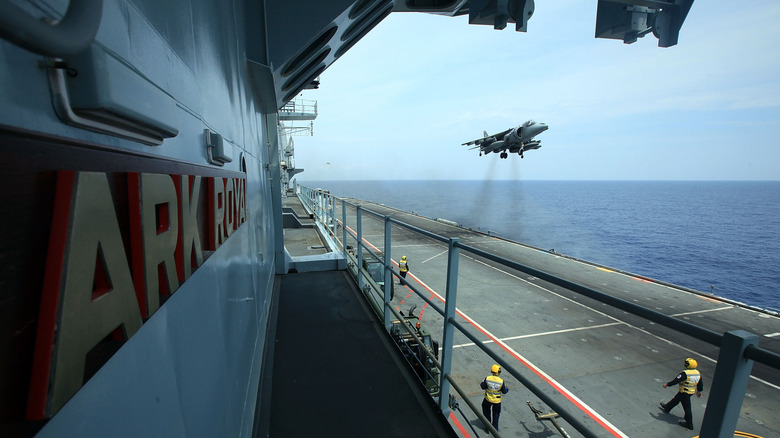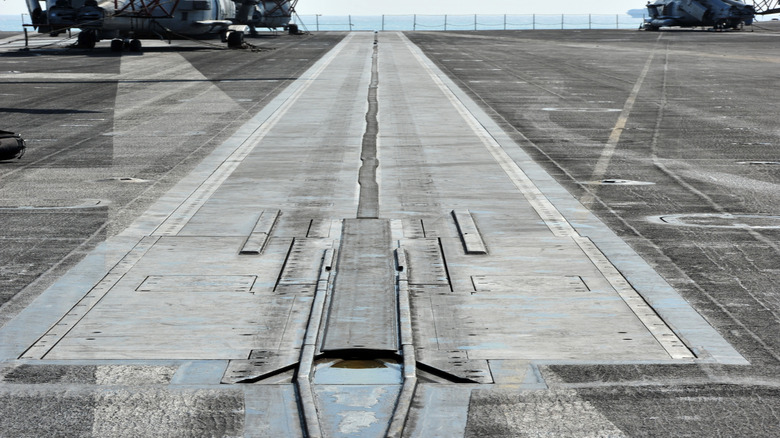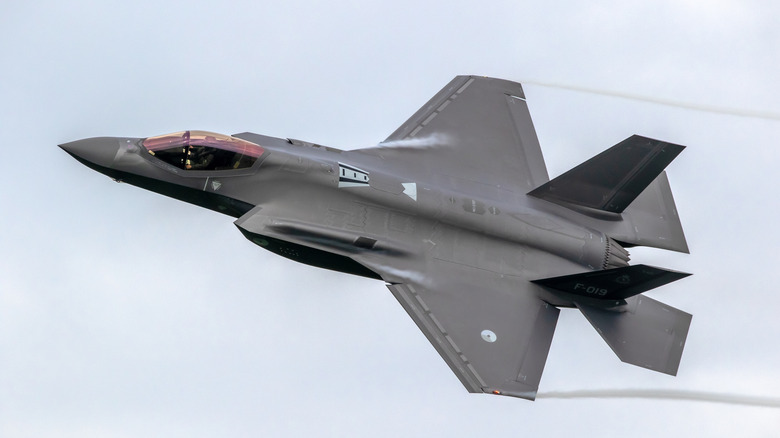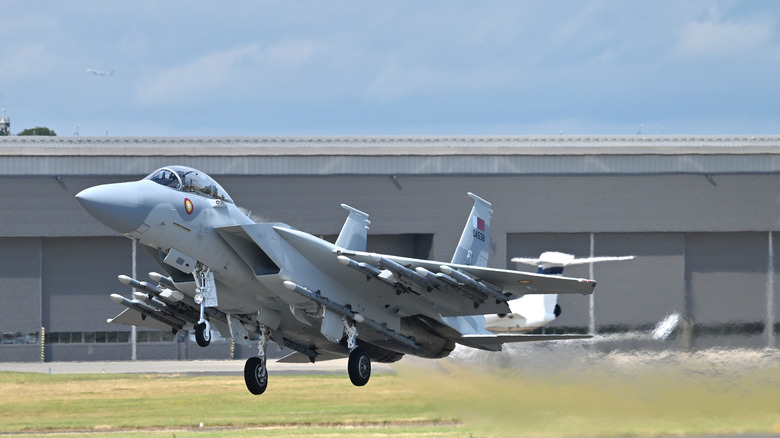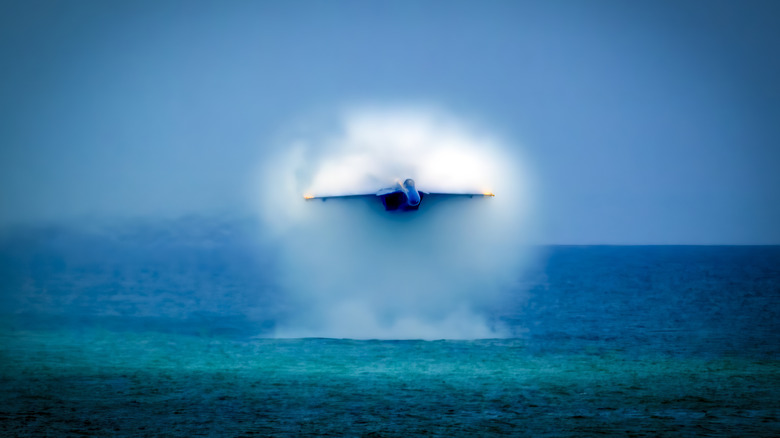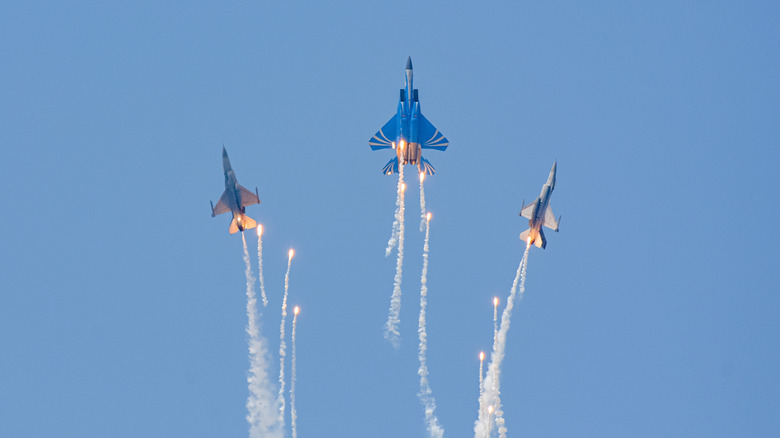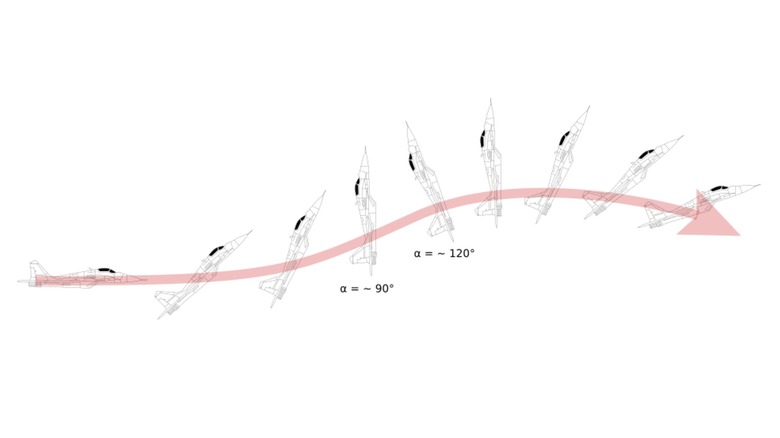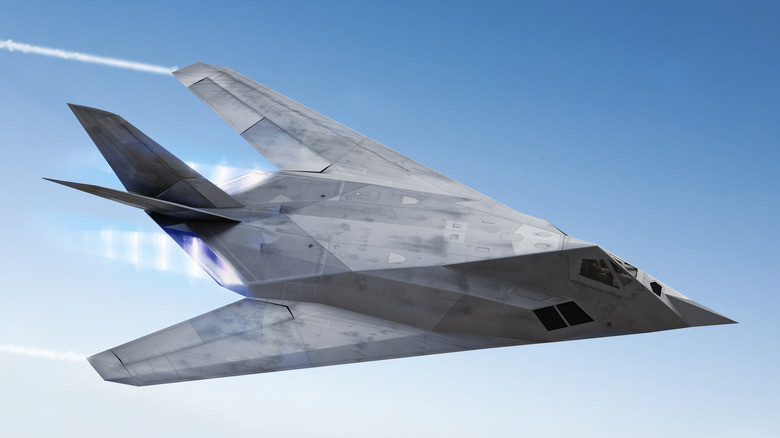10 Of The Coolest High-Tech Features Ever Utilized By Fighter Jets
Humans have always looked skyward in envy of birds, bees, and anything else that can take flight. Soaring up above the Earth has long been a task that occupied human minds, from the ancient Greek tale of Icarus launching himself into the winds (and then falling back down) to Leonardo da Vinci's 15th century flying machine designs.
When the Wright brothers managed to lift off the ground over a century ago, they ignited an impassioned sprint toward increasingly substantive innovations and technologies in aerospace. Exponential growth in the realm of aerial flight would eventually transform every aspect of the human experience. From shipping goods and delivering mail to launching a truly global tourism industry, human flight connects the world in ways that people just a few generations ago may have never thought possible.
Flight also changed the landscape of warfare. Observational spy balloons and aerial signaling have been used throughout human history. They formed a core intelligence gathering function in the American Civil War, but would soon be replaced by later airplane propulsion breakthroughs. The first fighter jet to participate in aerial combat was the German Messerschmitt Me 262, which attacked a British reconnaissance plane over Munich in 1944. The aircraft wasn't as impactful as the Germans would have hoped, but the gauntlet was laid down — jet engines were here to stay and tertiary systems quickly made them even more powerful weapons of war.
The sweepback wing and variable geometry designs
The first airplanes to take to the skies features straight wing geometry. The Wright brothers' fliers utilized fixed, rectangular wing designs that straddled the aircraft in a perpendicular fashion, connecting the wing on either side in the center. Wing design has changed a lot in the years since, however.
Many airplanes today feature a sweepback to their wings, from passenger airliners to fighter jets. They are consistently featured in fighters, however, because the design provides solid crossover between speed and maneuverability. A swept design is crucial for reducing aerodynamic drag, allowing an aircraft to travel faster and more efficiently when it crosses speed thresholds like the sound barrier. Its design was the result of decades of wind tunnel testing and at least partially inspired by the way birds and bats tuck back their wings while in flight to increase speed.
Most fighter jets today utilize wing geometry that sees them extend out (and back) at an angle rather than straight to achieve this improved efficiency. However, not all jets deliver this form factor. Some feature forward sweep in their wings, and others offer variable shape. The Mirage G was one of the first fighter jet to allow for adjustments while in flight, just like the creatures of the sky that we were emulating.
In-air refueling
The process of in-air refueling has been around for a very long time — almost as long as manned flight itself, actually. The first instance of in-air refueling took place in 1923, but it has come a long way in the century since its introduction. The first flights to test this method of prolonging time in the air were essentially test runs to explore how this process could work. They utilized a hose to transfer gasoline from one aircraft to another. In August of 1923, two pilots broke a variety of records with an endurance flight lasting 37 hours and 15 minutes, featuring 16 successful refueling operations mid-flight.
Today, the task of refueling while airborne is a commonplace feat of jet propulsion. Dedicated refueling vessels are a staple of the military's aerial fleet, with icons such as the S-3B Viking, originally designed to hunt Soviet submarines, serving for many years in this role. Whether taking off from land or sea-based carriers, extending the range of a fighter jet to expand its capacity to support ground forces or perhaps even engage in multiple dogfights over contested landscapes is a critical capability among modern fighter jets.
Vertical/Short Takeoff and Landing (V/STOL)
The ability to take off from a standstill remains one of the coolest technologies ever imbued in a non-helicopter craft. After all, the Harrier jet is an icon for one reason – its ability to hover in place and perform Vertical Takeoff and Landing (VTOL) operations. Popularized perhaps most vividly in pop culture as a feature of the 1994 Arnold Schwarzenegger film "True Lies," the Harrier is a feat of tremendous engineering.
The wing design of a normal aircraft is carefully crafted to ensure a gliding effect of air traveling above and below its curvature, creating lift in the process. So an airplane that isn't cutting through the air should be one that plummets back down to Earth. This isn't so for the Harrier, however, as it features nozzled engines that can produce vertical lift themselves, rather than relying on air speed to generate it. The result is an aircraft that can perform the same feats of flight that are otherwise reserved for the mighty helicopter.
Other aircraft like the OV-10 Bronco provided American forces with a reconnaissance plane that could take off on exceedingly short runways (STOL) — including dirt paths and other non-standard surfaces during the Vietnam War. The Soviet Antonov AN-2 biplane is another tool that delivered similar Short Takeoff and Landing chops for use as an agricultural services aircraft.
Tailhooks and the aircraft catapult
The aircraft catapult is another tool that has essentially been around since the dawn of human flight. The Wright brothers utilized launch equipment to get their aircraft off the ground and later flight capable vehicles would also rely on this assistance measure to support take off, too. However, the aircraft catapult gained new significance when the world went to war for a second time.
A naval variant of the British Spitfire fighter planes – known as Seafires — were outfitted with tailhooks to operate from sea-based positions and engage enemy planes over Malta, Italy, and North Africa. Launching aircraft from aquatic positions wasn't particularly difficult given the existing catapult technology, but landing on them has always proved a greater challenge. The use of tailhooks in coordination with catapult systems delivered much-needed consistency.
Today, this pair of systems has become the primary means of enabling ocean takeoffs that rely on a return to this mobile, sea-based landing strip. The tailhook and aircraft catapult allow fighter jets to operate from virtually anywhere in the world and reduce range requirements down to fractions of what they might be otherwise. This means that fighter jets can stay in the air longer in support of whatever mission they are tasked with because their takeoff and landing site is located within the theater of battle as well.
Situational awareness tools
Understanding the battlefield has been critical for as long as humans have gone to war with one another. Intelligence gathering operations have become increasingly sophisticated through the years, and nowhere is this more apparent than in aerial combat.
Fighter jets engage their enemies in a unique snippet of our three dimensional plane. Height is a critical resource in ground combat, sure, but it gains new meaning when translated onto the skies. Fighter jets require an array of situational awareness tools that help them defend against incoming attacks -– which sometimes originate from beyond their sight horizon or a thousand feet above their heads -– and acquire targets, across land, sea, and air.
The F-4 Phantom II is an excellent example of technically adept flying machine technology. The Phantom, first built in 1958, allowed its pilots to identify and target enemy aircraft from beyond its pilot's line of sight. Radar and missile upgrades helped the aircraft's crew deliver lethal force from a distance that wasn't immediately defensible. The fighter jet was credited with downing over 100 MiG fighters during the Vietnam War, and later variants helped suppress Iraqi opposition during the Gulf War.
The modern F-35 Lightning II operates with some of the most advanced targeting systems ever conceived. It features a helmet mounted display that brings all the information a pilot needs right into their field of vision, no matter where they're looking. The Electro-Optical Targeting System delivers air-to-air threat detection over tremendous range and helps to home in on precise ground targeting needs. The fighter jet also engages in seamless data sharing with other friendlies in the sky, allowing for heightened team cohesion.
Raw firepower
Any good fighter jet will need to be outfitted with an array of offensive weapons. From machine gun installations to nuclear-capable payloads, fighter jets have supported all manner of extreme weapons systems through the years.
One of the first fighter planes to lean full force into tremendous offensive load was the P-47 Thunderbolt. Although not a jet aircraft, this early workhorse exhibited immense capability when it came to downing enemy fighters over Europe and the Pacific. The P-47 carried eight .50 caliber machine guns and could also haul along 2,500 pounds of bombing munitions, packing a huge punch in both dogfighting and ground bombardment scenarios.
The trend of stacking as much firepower as possible into the armaments of a fighter jet has continued in the years since World War II concluded. The Thunderbolt's modern equivalent is the F-15EX Eagle II, sometimes called the Air Force's Missile Truck. It may just be the most heavily armed fighter to ever take to the skies. Taking its frame from the F-15, formerly a pure aerial fighter platform, the F-15EX Eagle II now offers 23 total weapon stations, a significant boost over its previous iteration's 17.
Speed and the supercruise capability
Fast means lethal, and aircraft have been chasing improvements in speed for as long as humans have been flying. There are numerous hurdles to navigate when seeking to create additional speed in the air, however. For one thing, fighter jets have become capable of moving at speeds that surpass standard human piloting capabilities. A phenomenon known as gravity-induced loss of consciousness takes place at a variety of different thresholds depending on who the operator is.
The average person may experience a blackout when moving at about 5Gs, while trained pilots (augmented with specialized equipment) can extend this range up to about 9Gs, given the right circumstances. Time at extreme speed and particularly the pace of acceleration also play a role in impairment and total blackout. Naturally, a pilot that loses consciousness is one threatened with the loss of their aircraft, and worse. Flight support systems like autopilot tools, onboard oxygen, and other technologies help pilots maintain control of the aircraft even when the physical toll becomes extreme.
The other barrier to intense speed is one that affects even everyday drivers on their local roadways — fuel economy. Afterburners, in particular, are a tool that can increase speed tremendously, but they burn fuel at a much faster rate as well. Engaging afterburners also ramps up the heat production of a fighter jet, making it more susceptible to enemy detection. However, technology such as Supercruise in the F-22 Raptor allows a pilot to ramp up speed without relying on afterburners, eliminating this detection issue and improving fuel usage.
Onboard countermeasures
Countermeasures are perhaps some of the lowest technically demanding features of a fighter jet. Even so, the use of low-tech defensive tools like chaff and flares can create a resoundingly spectacular display. Perhaps one of the most arresting visuals in the prequel "Star Wars" movies is seen during a space battle between Obi-Wan Kenobi and the menacing Jango Fett set in an asteroid field over the brilliant orange of Geonosis. The encounter features prominent usage of countermeasures by Obi Wan as he struggles to defend against the bounty hunter's missile attack.
In real aerial combat, the same discharge of physical countermeasures to scramble missiles and frazzle radar tracking tools can be seen today. Modern countermeasures not only feature a physical shielding options, but also come in the form of infrared defensive weapons and electronic countermeasures that can scramble an aggressor's capability to target or attack a jet. These IR countermeasures target the heat of a missile in flight, and then blast it with an infrared beam to incapacitate its tracking function. This makes the tool reusable and far less reliant on timing, luck, and slick maneuvering.
Thrust vectoring
Flying a fighter jet isn't like piloting a regular aircraft. These aircraft are controlled by immensely sensitive flight tools and have features that simply don't factor into the build of something like a passenger or cargo jet. Thrust vectoring, for instance, isn't required of a larger, transportation-focused jet engine, but make for a tremendously improved fighter jet.
Thrust vectoring allows for nuanced control of the engine exhaust direction, helping a pilot launch themselves into turns and other maneuvers with greater agility. This makes a fighter jet swifter in the turn and can help edge a battle in their favor. Thrust vectoring isn't a feature confined to the military realm, but it's far less common through sheer necessity in civilian aircraft.
Certain variants of the Russian MiG-29 feature thrust vectoring, making them just one of a few aircraft in the world that can perform a full Pugachev's Cobra maneuver, which requires a sudden shift in thrust direction to maintain flight. A Pugachev's Cobra involves violently pulling up on the nose of the aircraft to essentially stall it at a fully vertical orientation, with the angle of attack reaching an astounding 120 degrees. This rapidly halts the jet's forward speed before the pilot sinks the nose back down to its previous positioning.
The result is a capacity to let an enemy fighter completely pass the jet by, placing the MiG in prime attacking position behind its adversary. Thrust vectoring and other maneuverability features of the MiG-29 are responsible for the aircraft's ability to perform this astounding feat.
Stealth technologies
Stealth technologies are a core component in any fighter jet's ability to perform its duties. Part of the design specifics of a modern fighter involve hiding the vessel as much as possible. This includes shielding its aerial signature from radar systems on the ground, as well as making the aircraft harder to see in the air both visually and by the onboard identification systems of other planes.
Stealth inclusions come in a wide range of variations, but many are focused on unique skins for aircraft, as well as the angular shape of the vessel itself. Modern design language has sought to minimize flat surfaces and rounded edges. These features are easier to hit with sensor equipment, with the resulting ping bouncing more or less straight back to the receiver. Angular faces scatter the radar signal, making it harder to identify an aircraft in the first place, and equally difficult to actually find one that's been noticed.
Aircraft like the F-117 Nighthawk relied on aggressive angles to mitigate detection while the F-35 has been spotted in shiny outer colorations to achieve its stealth capabilities.
